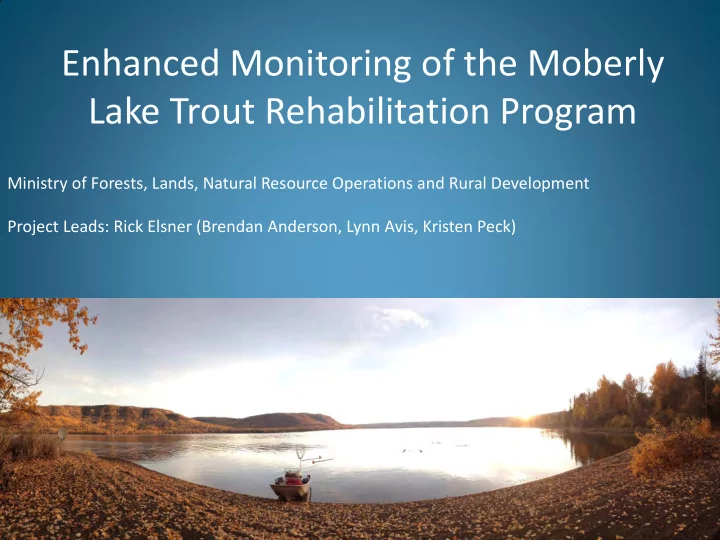

Enhanced Monitoring of the Moberly Lake Trout Rehabilitation Program Ministry of Forests, Lands, Natural Resource Operations and Rural Development Project Leads: Rick Elsner (Brendan Anderson, Lynn Avis, Kristen Peck)
Brief History • 2002 – low population abundance • 2005 – beginning of mark-recap program • 2005-2008 – evaluation of habitat suitability • 2010 – initiate stocking program • 2012-2016 – three cohorts of juveniles stocked
Objectives • 1. Track Lake trout abundance • 2. Monitor lake trout life history parameters • 3. Assess the success of rehabilitation cohorts • 4. Monitor the response of the Lake Whitefish population
Objective 1: Monitor Lake Trout Total Abundance and population trends • Mark-recapture – Marking: Annual spawning shoal targeted netting – Recapture: Spring Littoral Index Netting (SLIN)
Objective 1: Monitor Lake Trout Total Abundance and population trends • Recapture rates consistently >50% • Relatively high capture probability for mature males • Population growth rate 1.02 (95% CI 0.91-1.14) • Low but non-zero recruitment • Depressed state equilibrium • # Mature Upper Lower Total population Year SE Males 95% CI 95% CI ~360-570 2014 217 183 251 17 Mature fish 2015 224 185 263 20 based on a 1:1 2016 230 184 276 23 sex ratio 2017 235 180 289 28
Objective 1: Monitor Lake Trout Total Abundance and population trends
Objective 2: Monitor Lake Trout Life History Parameters
Objective 2: Monitor Lake Trout Life History Parameters • Survival is high ~90% (Pradel model) • Males spawn annually, females 1 out of every 2 years (Barker survival analysis) • Density dependant growth
Objective 2: Monitor Lake Trout Life History Parameters
Objective 3: Monitor survival, growth fitness and reproduction of stocked cohorts • SLIN • Opportunistic targeted netting • Incidental captures during targeted spawner netting
Objective 3: Monitor survival, growth fitness and reproduction of stocked cohorts
Objective 4: Monitor for changes in Lake Whitefish population • Hydroacoustic survey with gillnet validation • Initial years of sampling provide baseline • Monitoring for shifts in abundance
Objective 4: Monitoring cont’d Lake Whitefish a) 800,000 700,000 600,000 500,000 400,000 300,000 200,000 100,000 - 2013 2014 2015 2016 2017 Pygmy Whitefish b) 2,500,000 2,000,000 1,500,000 1,000,000 500,000 - 2013 2014 2015 2016 2017
Accomplishments and Implications for Conservation • Establishing indexing approach for whitefish species monitoring • New record of pygmy whitefish in BC
Accomplishments and Implications for Conservation • Development of sustainable long term core monitoring program – Population estimates based on male spawning population – Allows for robust population abundance estimates from single sampling session annually – Allows for evaluation of population parameters: survival, recruitment, mortality, population growth rate
Accomplishments and Implications for Conservation • Evaluate Success of Rehabilitation Program • Most rigorous absolute abundance lake trout estimates in BC • Potential future applications for Lake Trout Stock recovery in BC • Identification of other depressed LT populations at equilibrium?
Future Directions • Continue fall spawner • Next 3-5 years surveys implement another SLIN/Hydroacoustic – Monitor adult male population survey – Monitor stocked juvenile recruitment
Acknowledgements
Egg Take
Hatchery fish Release
Recommend
More recommend